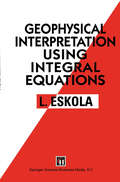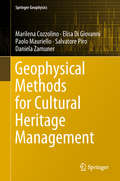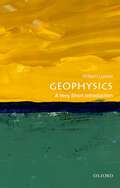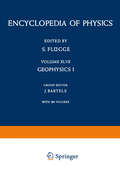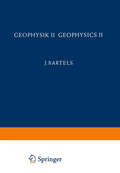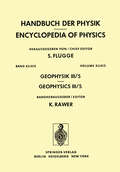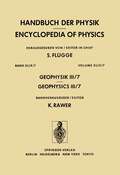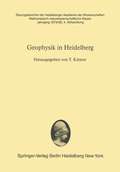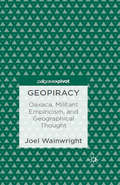- Table View
- List View
Geophysical Fluid Dynamics II: Stratified / Rotating Fluid Dynamics of the Atmosphere—Ocean (Springer Textbooks in Earth Sciences, Geography and Environment)
by Emin ÖzsoyThis book develops a fundamental understanding of geophysical fluid dynamics based on a mathematical description of the flows of inhomogeneous fluids. It covers these topics:1. development of the equations of motion for an inhomogeneous fluid 2. review of thermodynamics 3. thermodynamic and kinetic energy equations 4. equations of state for the atmosphere and the ocean, salt, and moisture effects 5. concepts of potential temperature and potential density 6. Boussinesq and quasi-geostrophic approximations 7. conservation equations for vorticity, mechanical and thermal energy instability theories, internal waves, mixing, convection, double-diffusion, stratified turbulence, fronts, intrusions, gravity currentsGraduate students will be able to learn and apply the basic theory of geophysical fluid dynamics of inhomogeneous fluids on a rotating earth, including:1. derivation of the governing equations for a stratified fluid starting from basic principles of physics 2. review of thermodynamics, equations of state, isothermal, adiabatic, isentropic changes 3. scaling of the equations, Boussinesq approximation, applied to the ocean and the atmosphere 4. examples of stratified flows at geophysical scales, steady and unsteady motions, inertia-gravity internal waves, quasi-geostrophic theory 5. vorticity and energy conservation in stratified fluids6.boundary layer convection in stratified containers and basins
Geophysical Hazards: Minimizing Risk, Maximizing Awareness (International Year of Planet Earth)
by Tom BeerThe International Year of Planet Earth (IYPE) was established as a means of raising worldwide public and political awareness of the vast, though frequently under-used, potential the Earth Sciences possess for improving the quality of life of the peoples of the world and safeguarding Earth’s rich and diverse environments. The International Year project was jointly initiated in 2000 by the International Union of Geological Sciences (IUGS) and the Earth Science Division of the United Nations Educational, Scienti?c and Cultural Organisation (UNESCO). IUGS, which is a Non-Governmental Organisation, and UNESCO, an Inter-Governmental Orga- sation, already shared a long record of productive cooperation in the natural sciences and their application to societal problems, including the International Geoscience Programme (IGCP) now in its fourth decade. With its main goals of raising public awareness of, and enhancing research in the Earth sciences on a global scale in both the developed and less-developed countries of the world, two operational programmes were demanded. In 2002 and 2003, the Series Editors together with Dr. Ted Nield and Dr. Henk Schalke (all four being core members of the Management Team at that time) drew up outlines of a Science and an Outreach Programme. In 2005, following the UN proclamation of 2008 as the United Nations International Year of Planet Earth, the “Year” grew into a triennium (2007–2009).
Geophysical Interpretation using Integral Equations
by L. EskolaAlong with the general development of numerical methods in pure and applied to apply integral equations to geophysical modelling has sciences, the ability improved considerably within the last thirty years or so. This is due to the successful derivation of integral equations that are applicable to the modelling of complex structures, and efficient numerical algorithms for their solution. A significant stimulus for this development has been the advent of fast digital computers. The purpose of this book is to give an idea of the principles by which boundary-value problems describing geophysical models can be converted into integral equations. The end results are the integral formulas and integral equations that form the theoretical framework for practical applications. The details of mathematical analysis have been kept to a minimum. Numerical algorithms are discussed only in connection with some illustrative examples involving well-documented numerical modelling results. The reader is assu med to have a background in the fundamental field theories that form the basis for various geophysical methods, such as potential theory, electromagnetic theory, and elastic strain theory. A fairly extensive knowledge of mathematics, especially in vector and tensor calculus, is also assumed.
Geophysical Inverse Theory
by Robert L. ParkerIn many physical sciences, the most natural description of a system is with a function of position or time. In principle, infinitely many numbers are needed to specify that function, but in practice only finitely many measurements can be made. Inverse theory concerns the mathematical techniques that enable researchers to use the available information to build a model of the unknown system or to determine its essential properties. In Geophysical Inverse Theory, Robert Parker provides a systematic development of inverse theory at the graduate and professional level that emphasizes a rigorous yet practical solution of inverse problems, with examples from experimental observations in geomagnetism, seismology, gravity, electromagnetic sounding, and interpolation. Although illustrated with examples from geophysics, this book has broad implications for researchers in applied disciplines from materials science and engineering to astrophysics, oceanography, and meteorology. Parker's approach is to avoid artificial statistical constructs and to emphasize instead the reasonable assumptions researchers must make to reduce the ambiguity that inevitably arises in complex problems. The structure of the book follows a natural division in the subject into linear theory, in which the measured quantities are linear functionals of the unknown models, and nonlinear theory, which covers all other systems but is not nearly so well understood. The book covers model selection as well as techniques for drawing firm conclusions about the earth independent of any particular model.
Geophysical Inverse Theory (Princeton Series in Geophysics #1)
by Robert L. ParkerIn many physical sciences, the most natural description of a system is with a function of position or time. In principle, infinitely many numbers are needed to specify that function, but in practice only finitely many measurements can be made. Inverse theory concerns the mathematical techniques that enable researchers to use the available information to build a model of the unknown system or to determine its essential properties. In Geophysical Inverse Theory, Robert Parker provides a systematic development of inverse theory at the graduate and professional level that emphasizes a rigorous yet practical solution of inverse problems, with examples from experimental observations in geomagnetism, seismology, gravity, electromagnetic sounding, and interpolation. Although illustrated with examples from geophysics, this book has broad implications for researchers in applied disciplines from materials science and engineering to astrophysics, oceanography, and meteorology. Parker's approach is to avoid artificial statistical constructs and to emphasize instead the reasonable assumptions researchers must make to reduce the ambiguity that inevitably arises in complex problems. The structure of the book follows a natural division in the subject into linear theory, in which the measured quantities are linear functionals of the unknown models, and nonlinear theory, which covers all other systems but is not nearly so well understood. The book covers model selection as well as techniques for drawing firm conclusions about the earth independent of any particular model.
Geophysical Methods for Cultural Heritage Management (Springer Geophysics)
by Marilena Cozzolino Elisa Di Giovanni Paolo Mauriello Salvatore Piro Daniela ZamunerThis book provides information and tools necessary to bridge and integrate the knowledge gaps related to the acquisition and processing of archaeological data, specifically in the field of preventive diagnostics, urban centers, archaeological parks and historical monuments, through activities that involve the application of non-invasive diagnostic detection systems, in the field of applied geophysics. The principal aim of this book is to define a tool for experts that work in the frame of Cultural Heritage and to identify a procedure of intervention transferable and usable in different geographical contexts and areas of investigations: it could help to decide the better technique of investigation to apply in relation to the predictive characteristics of the archaeological site and the objectives of the survey. The book is divided in two parts. The first one explains the theory of ground high resolution penetrating radar (GPR), electrical resistivity tomography (ERT), controlled source electromagnetism system, differential magnetic method and the scenario of integrated methods of different geophysical techniques. Each section covers the basic theory (complete description of the physical parameters involved in the method), field instruments (description of all systems actually offered by commercial companies), field techniques (presentation of the main procedures and setting parameters used to explore the ground surface during data acquisition), techniques of data processing and representation (main processing routines and comparison between different techniques; presentation of different typologies of graphical representation), and the possibility and limitations of methods (explanation of best and worst conditions of implementation of the geophysical technique in relation to the contrasts between archaeological features and the natural background and the features of the instruments and arrays). The second part describes some applications of geophysical prospection to Cultural Heritage in detailed case histories, divided in sections relative to monuments, historical buildings, urban centres, archaeological parks and ancient viability. Moreover, examples of integration of three-dimensional reliefs and geophysical diagnostic of a monuments and studies of large scale reconnaissance implemented into a Geographical Information System are treated. In each case study the authors cover the description of the archaeological or historical contest; an explanation of the problem to solve; a choice of the geophysical methods; the setting of the procedure of data acquisition; techniques of data processing; a representation, interpretation, and discussion of the results.
Geophysical Monitoring for Geologic Carbon Storage (Geophysical Monograph Series)
by Lianjie HuangGeophysical Monitoring for Geologic Carbon Storage Geophysical Monitoring for Geologic Carbon Storage Storing carbon dioxide in underground geological formations is emerging as a promising technology to reduce carbon dioxide emissions in the atmosphere. A range of geophysical techniques can be deployed to remotely track carbon dioxide plumes and monitor changes in the subsurface, which is critical for ensuring for safe, long-term storage. Geophysical Monitoring for Geologic Carbon Storage provides a comprehensive review of different geophysical techniques currently in use and being developed, assessing their advantages and limitations. Volume highlights include: Geodetic and surface monitoring techniques Subsurface monitoring using seismic techniques Subsurface monitoring using non-seismic techniques Case studies of geophysical monitoring at different geologic carbon storage sites The American Geophysical Union promotes discovery in Earth and space science for the benefit of humanity. Its publications disseminate scientific knowledge and provide resources for researchers, students, and professionals.
Geophysical Monitoring for Geologic Carbon Storage (Geophysical Monograph Series)
by Lianjie HuangGeophysical Monitoring for Geologic Carbon Storage Geophysical Monitoring for Geologic Carbon Storage Storing carbon dioxide in underground geological formations is emerging as a promising technology to reduce carbon dioxide emissions in the atmosphere. A range of geophysical techniques can be deployed to remotely track carbon dioxide plumes and monitor changes in the subsurface, which is critical for ensuring for safe, long-term storage. Geophysical Monitoring for Geologic Carbon Storage provides a comprehensive review of different geophysical techniques currently in use and being developed, assessing their advantages and limitations. Volume highlights include: Geodetic and surface monitoring techniques Subsurface monitoring using seismic techniques Subsurface monitoring using non-seismic techniques Case studies of geophysical monitoring at different geologic carbon storage sites The American Geophysical Union promotes discovery in Earth and space science for the benefit of humanity. Its publications disseminate scientific knowledge and provide resources for researchers, students, and professionals.
Geophysical Studies in the Caucasus (Lecture Notes in Earth System Sciences)
by Lev Eppelbaum Boris KhesinThe subject of this book is the methodology and results of integrated geophysical investigations in the Caucasian region, mainly interpretation of magnetic and gravity anomalies with utilization of a huge petrophysical database for the evaluation of geological structure and mineral resources. Relative voluminous geophysical data are useful for the Earth Sciences researchers interested in the Caucasian region (and adjacent and similar regions) characterized by complicated geological structure, inclined magnetization (polarization), uneven topography and mountain/sea transition. Examination of geophysical fields verified by super-deep wells drilling indicates that magmatic rocks of the Lesser Caucasus are extended northward under thick sedimentary cover of the Kura Depression up to the Greater Caucasus. These rocks form hidden petroleum-bearing traps of a newly identified type. On the basis of geophysical studies (mainly inexpensive magnetic and electric methods), a new copper-polymetallic province in the Greater Caucasus has been revealed. a newly developed integrated approach and special information-statistical techniques for processing and interpretation of geophysical data facilitate detection of important geological features, e.g. hidden intersections of linear structures that control location of large commercial ore and oil-and-gas deposits, as well as focuses of dangerous geodynamic events at a depth. Numerous illustrations (including colour) elucidate different problems and solutions on various scales and in diverse geological-geophysical environments. Many aspects of this book have been presented at the teaching courses for bachelors, masters and doctors at the Tel-Aviv University (Tel Aviv, Israel) and Ben-Gurion University (Be’er-Sheva, Israel). Benefits to readers are predetermined by the combination of the authors many-years personal experience in the geophysical studies of Azerbaijan and other regions of the Caucasus with the authors' knowledge of the modern level of geophysics in the world.
Geophysics in Mining and Environmental Protection (GeoPlanet: Earth and Planetary Sciences)
by Adam F. Idziak and Ryszard DubielThis book contains contributions to the 32nd Polish-Czech-Slovak Symposium on Mining and Environmental Geophysics held in May 2009 in Piechowice (Poland). The papers are related to various aspects of geophysical science such as induced seismicity, engineering seismology, environmental geophysics and geophysics in geology
Geophysics of the Canary Islands: Results of Spain's Exclusive Economic Zone Program
by Peter Clift Juan AcostaThis book contains the results of a 9 year (1995-2004) investigation of the Canary Islands Exclusive Economic Zone, using state of the art technology. The coverage includes a multibeam survey demonstrating the magnitude of catastrophic failures of the Canary Islands; a comparison of the morphology of the Canary Islands with Hawaii; evaluation of hydrothermal activity associated with Mesozoic salt diapirs; and many more articles.
Geophysics: A Very Short Introduction (Very Short Introductions)
by William LowrieGeophysics is the physics of the Earth. Central to the Earth Sciences today, it encompasses areas such as seismology, volcanism, plate tectonics, gravitational anomalies, and the Earth's magnetic field (present and past, as captured in rocks), all of which give clues to both the structure and the working of the Earth. In this Very Short Introduction, William Lowrie describes the internal and external processes that affect the planet, as well as the principles and methods of geophysics used to investigate them. He explains how analysis of the seismic waves produced in earthquakes reveals the internal structure of the Earth. Geophysicists have established that the greatest source of energy powering geological processes is the Earth's internal heat. Deep inside the Earth, the temperature is high enough to produce a fluid outer core of molten iron. It is the motion in this molten iron layer that produces the Earth's magnetic field, which shields the planet against harmful radiation from the Sun and outer space, and thus makes the planet habitable. Lowrie describes how the magnetic field also magnetizes rocks during their formation, leaving a permanent record of the ancient field and its direction that geophysicists have learned to use to interpret past motions of the continents and tectonic plates. From analyses of Earth's deepest interior to measurements made from Earth-orbiting satellites, Lowrie shows how geophysical exploration is vitally important in the search for mineral resources, and emphasizes our need to understand the history of our planet and the processes that govern its continuing evolution. ABOUT THE SERIES: The Very Short Introductions series from Oxford University Press contains hundreds of titles in almost every subject area. These pocket-sized books are the perfect way to get ahead in a new subject quickly. Our expert authors combine facts, analysis, perspective, new ideas, and enthusiasm to make interesting and challenging topics highly readable.
Geophysics: A Very Short Introduction (Very Short Introductions)
by William LowrieGeophysics is the physics of the Earth. Central to the Earth Sciences today, it encompasses areas such as seismology, volcanism, plate tectonics, gravitational anomalies, and the Earth's magnetic field (present and past, as captured in rocks), all of which give clues to both the structure and the working of the Earth. In this Very Short Introduction, William Lowrie describes the internal and external processes that affect the planet, as well as the principles and methods of geophysics used to investigate them. He explains how analysis of the seismic waves produced in earthquakes reveals the internal structure of the Earth. Geophysicists have established that the greatest source of energy powering geological processes is the Earth's internal heat. Deep inside the Earth, the temperature is high enough to produce a fluid outer core of molten iron. It is the motion in this molten iron layer that produces the Earth's magnetic field, which shields the planet against harmful radiation from the Sun and outer space, and thus makes the planet habitable. Lowrie describes how the magnetic field also magnetizes rocks during their formation, leaving a permanent record of the ancient field and its direction that geophysicists have learned to use to interpret past motions of the continents and tectonic plates. From analyses of Earth's deepest interior to measurements made from Earth-orbiting satellites, Lowrie shows how geophysical exploration is vitally important in the search for mineral resources, and emphasizes our need to understand the history of our planet and the processes that govern its continuing evolution. ABOUT THE SERIES: The Very Short Introductions series from Oxford University Press contains hundreds of titles in almost every subject area. These pocket-sized books are the perfect way to get ahead in a new subject quickly. Our expert authors combine facts, analysis, perspective, new ideas, and enthusiasm to make interesting and challenging topics highly readable.
Geophysik (Springer-Lehrbuch)
by Michel CaraAusgehend von den physikalischen Eigenschaften des Planeten Erde werden die wesentlichen Methoden der Geophysik vorgestellt: Seismologie, Gravimetrie und Geodäsie, Geomagnetismus. Die Anwendung dieser Methoden auf die Lagerstättensuche, natürliche Risiken, den Untergrund und die Erfassung von Atombombenexplosionen wird ebenso beschrieben wie der Stand der seismischen, gravimetrischen, elektrischen und elektromagnetischen Forschung. Modelle für das Erdinnere und mathematische Grundlagen runden dieses einführende Lehrbuch ab. Jedes Kapitel enthält Übungen, die das Verständnis prüfen und deren Antworten im Anhang gegeben werden. Als Begleiter zu Lehrveranstaltungen in Geophysik und als zusätzliche Information wendet es sich an Dozenten und Studenten der Geophysik und Geologie sowie verwandter Fächer mit Geophysik als Nebenfach.
Geophysik an Altlasten: Leitfaden für Ingenieure, Naturwissenschaftler und Juristen
by Dieter VogelsangLokalisierung und Sanierung von Altlasten entwickeln sich zu den zentralen Aufgaben von Naturwissenschaftlern, Ingenieuren und Beamten von regionalen, nationalen und internationalen Behörden im Umweltbereich. Geophysik an Altlasten gibt diesem Kreis einen sehr praxisorientierten Leitfaden in die Hand. Schwerpunkte hat der Autor auf die kostensparende und zerstörungsfreie Anwendung geophysikalischer Erkundungsmethoden gelegt. Illustriert durch eine große Zahl von Beispielen aus der Praxis schildert er die Planung, Ausschreibung und Durchführung von Projekten.
Geophysik an Altlasten: Leitfaden für Ingenieure, Naturwissenschaftler und Juristen
by Dieter VogelsangDas Auffinden und die Sanierung von Altlasten entwickelt sich zu einer der zentralen Aufgaben von Naturwissenschaftlern, Ingenieuren und Beamten von regionalen, nationalen und internationalen Behörden im Umweltbereich. Geophysik an Altlasten gibt diesem Kreis einen sehr praxisorientierten Leitfaden in die Hand. Schwerpunkte hat der Autor auf die kostensparende und zerstörungsfreie Anwendung geophysikalischer Erkundungsmethoden gelegt. Illustriert durch eine große Zahl von Beispielen aus der Praxis schildert er die Planung, Ausschreibung und Durchführung von Projekten. In der zweiten Auflage behandelt der Autor zusätzlich Luftschallseismik, Radarerkundung nuklearer Endlager und die Gefährdung durch Radioaktivität. Die Beschreibung der geophysikalischen Methoden wurde so weit ergänzt, daß dieses Buch auch als Einführung in die angewandte Geophysik für mathematisch ungeübte Studenten benutzt werden kann.
Geophysik II / Geophysics II (Handbuch der Physik Encyclopedia of Physics #10 / 48)
by Julius Bartels45 downwards because (j on the average increases with height; but this conclusion does not follow from (18.3) when the dependency of Kc upon ~o is taken into consideration. s 2 ERTELl and PRIESTLEY and SWINBANK have shown that the upward eddy flux of sensible heat must be larger than indicated by (18.3), because this formula does not account for the fact that rising eddies are systematically warmer than sinking eddies because of the effect of buoyancy. The reader is referred to the reviews by SUTTON [22], [23] and PRIESTLEY and SHEP PARD [15) for further details concerning eddy-flux of heat and turbulent diffusion. 19. RICHARDSON'S criterion. The right-hand side of (15.10) represents the rate of production of eddy energy. The last term represents energy loss by dissipation; in order that the eddy energy shall be maintained, it is therefore necessary that P div V" - (! V" v" . grad. v > O.
Geophysik III / Geophysics III: Teil V / Part V (Handbuch der Physik Encyclopedia of Physics #10 / 49 / 5)
by Ja. L. Al'pert T. K. Breus K. I. Gringauz W. L. Jones A. T. Vassy E. Vassy W. L. WebbGeophysik III / Geophysics III: Teil II / Part II (Handbuch der Physik Encyclopedia of Physics #10 / 49 / 2)
by J. BartelsGeophysik III / Geophysics III (Handbuch der Physik Encyclopedia of Physics #10 / 49 / 7)
by G. Schmidtke K. Suchy K. RawerThis Encyclopedia aims, basically, at summanzmg the wealth of well established facts and outlining the relevant theories in the different branches of physics. With this as goal, the writers were asked to present their specific field in such a way that access is possible to any scientist without special a priori information in that field; the basic concepts of physics are assumed to be known to the reader. The survey given in each paper was also to be long lasting, so that even a few years after publication, each volume would be useful, for example as an introduction for newcomers or as a source of information for workers in a neighbouring field. In the field of geophysics, dealt with in Vols. 47--49 of the Encyclopedia, this task is difficult to achieve because during the last decades there has been a much faster development of basic information and theory than during the decades before. When I came to contribute to this work the famous Julius Bartels, then editor of the geophysical part, told me that Vol. 49 should certainly take into account the results of the "International Geophysical Year" 1957/58 (I. G. Y. ), and that we had better wait until these were accessible than produce a kind of information which might be obsolete in a short time.
Geophysik in Heidelberg: Eine Darstellung der Arbeitsgebiete und bisherigen Ergebnisse Heidelberger Institute zur Geophysik (Sitzungsberichte der Heidelberger Akademie der Wissenschaften #1979/80 / 4)
by T. KirstenGeopiracy: Oaxaca, Militant Empiricism, and Geographical Thought
by Joel WainwrightGeopiracy is a study of the 'Bowman expeditions'—a project through which geographers, with funding from the US Army, are mapping the 'human terrain' of foreign lands. Wainwright offers a critique of human geography today that draws on contemporary social theory to raise unsettling questions about the nature of geography's disciplinary formation.
Geopoetics in Practice (Routledge Research in Culture, Space and Identity)
by Sarah De Leeuw Linda Russo Eric Magrane Craig Santos PerezThis breakthrough book examines dynamic intersections of poetics and geography. Gathering the essays of an international cohort whose work converges at the crossroads of poetics and the material world, Geopoetics in Practice offers insights into poetry, place, ecology, and writing the world through a critical-creative geographic lens. This collection approaches geopoetics as a practice by bringing together contemporary geographers, poets, and artists who contribute their research, methodologies, and creative writing. The 24 chapters, divided into the sections “Documenting,” “Reading,” and “Intervening,” poetically engage discourses about space, power, difference, and landscape, as well as about human, non-human, and more-than-human relationships with Earth. Key explorations of this edited volume include how poets engage with geographical phenomena through poetry and how geographers use creativity to explore space, place, and environment. This book makes a major contribution to the geohumanities and creative geographies by presenting geopoetics as a practice that compels its agents to take action. It will appeal to academics and students in the fields of creative writing, literature, geography, and the environmental and spatial humanities, as well as to readers from outside of the academy interested in where poetry and place overlap.


